Detection
A mesocyclone is defined as a (usually cyclonic) concentration of vertical vorticity around 2–10 km in diameter within a convective storm. The vertical vorticity associated with a mesocyclone is often on the order of 10−2 s−1 or greater. It should be noted that a mesocyclone is not just any cyclone on the mesoscale; it refers specifically to cyclones within convective storms. Mesocyclones are frequently found in conjunction with the updraft and Rear Flank Downdraft (RFD) in supercells. Supercell tornadoes sometimes form in mesocyclones. Persistent mesocyclones that have significant vertical extent are detected by Doppler radar as mesocyclone signatures.
Use the radio buttons or click the image to switch between reflectivity and velocity imagery:
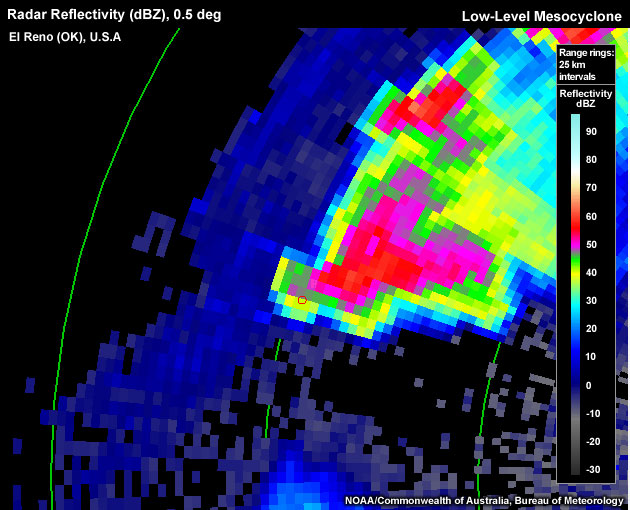
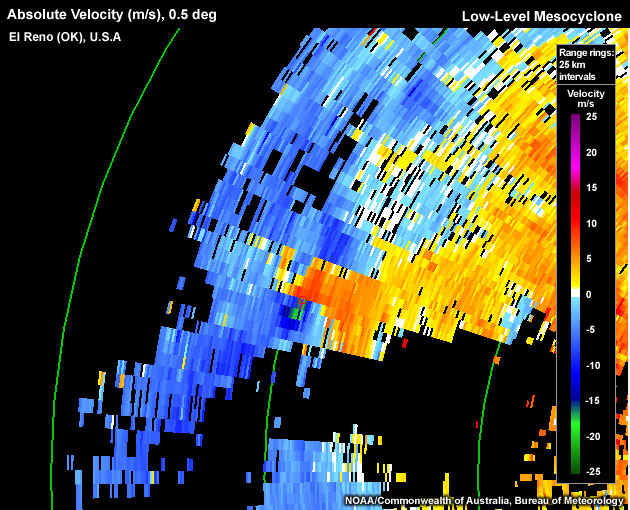
Strong anti-clockwise Low-Level Mesocyclone signature with a clear inbound/outbound couplet. The inbound branch shows aliasing. The mesocyclone is located near the southwestern corner of the low-level reflectivity core in this right-moving supercell.
A Low-Level Mesocyclone is a storm-scale, usually cyclonic circulation in the low levels of a thunderstorm that satisfies the mesocyclone definition. It is common to use the lowest couple of radar scans when attempting to detect this feature. Naturally, a Low-Level Mesocyclone would be found in the vicinity of the RFD and updraft in supercell thunderstorms. Remember that a supercell storm is any storm containing a mesocyclone.
For rotation within convective storms to be classified as a mesocyclone, the vortex generally needs:
- to be of storm scale (2-10 km in diameter),
- have reasonable (~3 km) vertical depth,
- have sufficient duration (two or more successive radar volume scans),
- and meet at least a minimum rotational velocity (~15 ms-1).
These criteria have been used as quantitative values in the National Severe Storms Laboratory (NSSL) and U.S. National Weather Service (NWS) mesocyclone definition.
To detect a Low-Level Mesocyclone you could use the following techniques:
Reflectivity: PPI/Plan View
Determining updraft location:
- Step up in elevation scans until you run out of >50 dBZ echoes.
- Step down one elevation scan.
- Centre cursor on the upshear side of >50 dBZ core (this is to account for storm movement in strong winds aloft which results in core movement between the lowest and storm top-level radar scans).
- Set a reference point.
- Step down to the lowest couple of levels of the thunderstorm. This reference point should be at the location where a mesocyclone would be expected. Now switch to velocity data.
Velocity: PPI/Plan View
- In the vicinity of the reference point, look for local inbound and outbound velocity maxima close to each other. Both velocity maxima should be at about the same range from the radar. Depending upon the component of the storm motion towards/away from the radar, the rotation may not be displayed as a symmetric inbound/outbound couplet but may show a possibly highly asymmetric couplet. Even without any storm motion, or in a storm-relative frame of reference, mesocyclones rarely manifest themselves as fully symmetric couplets. See the examples section for a demonstration of this couplet asymmetry.
Potential Difficulties in Detection
- Aliasing – Observed radial velocities that are higher than the Nyquist velocity of the radar and therefore the value is phase shifted by half a wavelength, often display pixels as the opposite sign. If this is not detected, the forecaster may conclude the observed data is travelling in the opposite direction to which it actually is, hiding potential mesocyclone signatures.
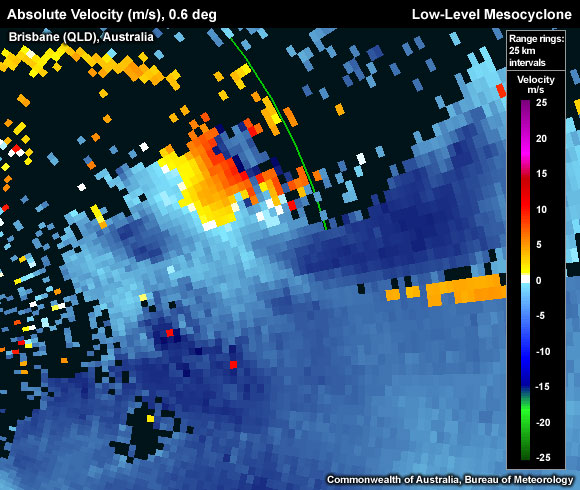
Cyclonic mesocyclone with aliased inbound velocity (dark blue).
- Rapidly translating mesocyclones - When either the storm is moving quickly or there is a strong background flow, a mesocyclone signature might be hard to recognise due to the often non-symmetrical inbound/outbound couplet. In some cases the entire signature may be all outbound (when the storm moves rapidly away from the radar) or all inbound (when it moves rapidly toward the radar). The signature may be composed, for example, of very strongly outbound velocity next to less strongly outbound velocity.
- Poor velocity data - Confidence in pixels, especially extreme values, is lowered; "hot pixels" are possible due to unfolding algorithm failures for radars that run dual pulse repetition frequencies. A check for spatial and temporal continuity can identify most velocity data contaminations of this type.
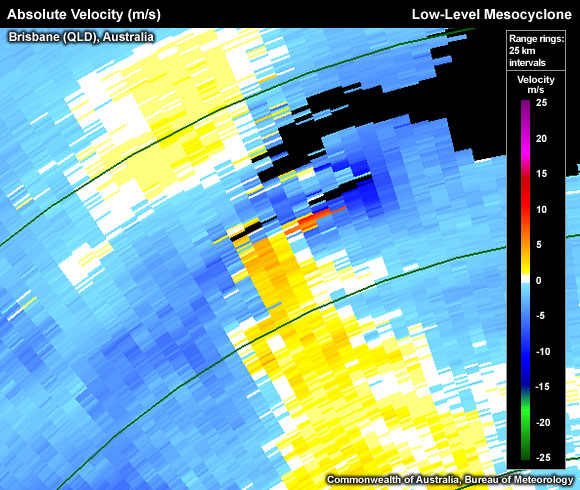
Cyclonic mid-level mesocyclone with unrealistic orange/red "poor quality" data pixels. Stepping up and down as well as forwards and backwards in time would reveal that these "hot pixels" suddenly appear and disappear, strongly indicating that these are not physical in origin but are radar artefacts.
- Resolution degradation as:
- Range increases – Radar sampling degrades due to increasing beam width which increasingly smoothes out the sharp velocity gradients in a mesocyclone.
- Mesocyclone size decreases – Radar sampling of the mesocyclone degrades for the same reason as above; "mini supercells" with small mesocyclones are particularly prone to this type of sampling problem ("partial beam filling").
- Timing of radar sampling – Mesocyclone could exist for nearly 20 mins and only be captured on 1 scan for radars that take 10 minute volume scans.
- Beam Height:
- If the thunderstorm is far away from the radar it becomes increasingly likely that the radar beam overshoots the low-level mesocyclone (in addition to the beam width problems mentioned above).
Examples ofLow-Level Mesocyclones
Use the radio buttons or click the image to switch between reflectivity and velocity imagery:


Very clean and tight low-level mesocyclone rotating counter-clockwise associated with a right-moving supercell west of Oklahoma City on 24 April 2006. In a storm environment supportive of tornadoes, this signature would indicate a significant probability of tornadogenesis.
Use the radio buttons or click the image to switch between reflectivity and velocity imagery:
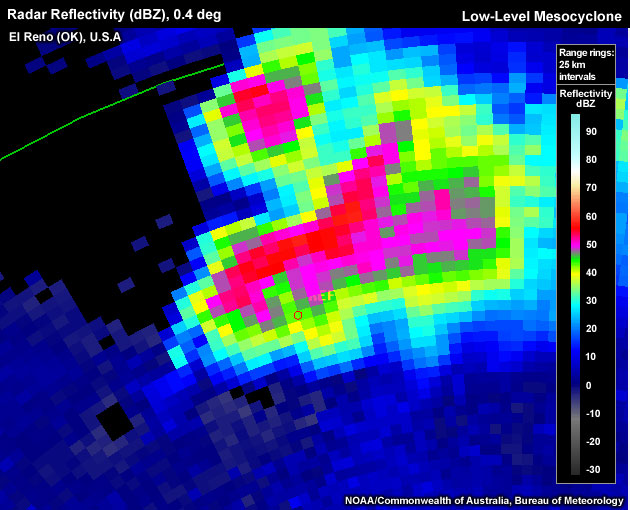
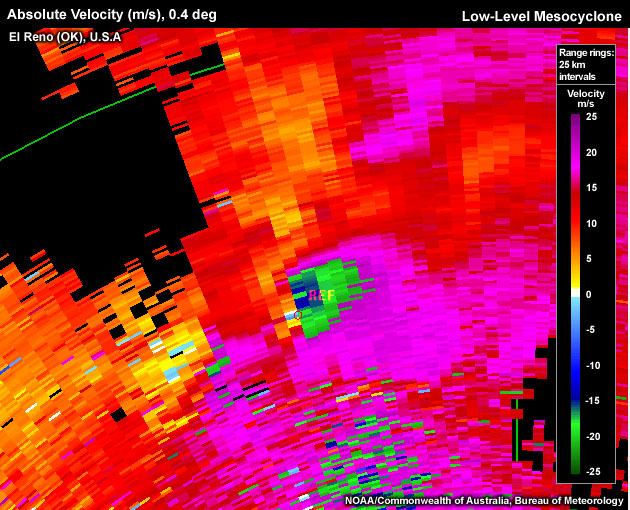
Base velocity signature of a anti-clockwise low-level mesocyclone in a supercell that is rapidly moving to the northeast (north of Oklahoma City, 3 May 1999). Due to the rapid translation of the signature, the inbound branch shows very weak values, whereas the outbound branch is strongly aliased.
Use the radio buttons or click the image to switch between reflectivity and velocity imagery:
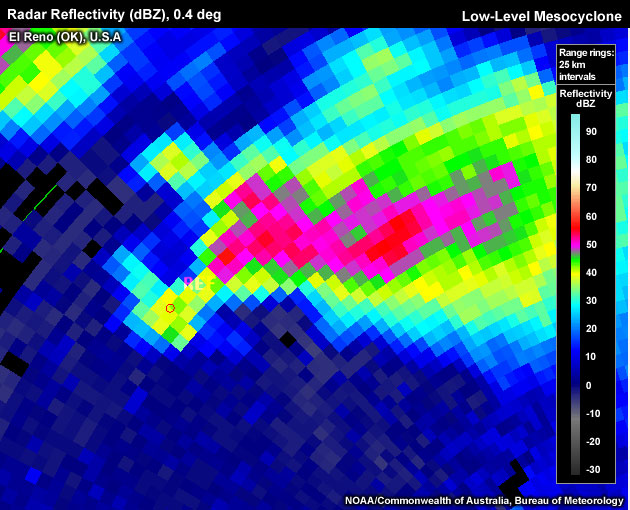
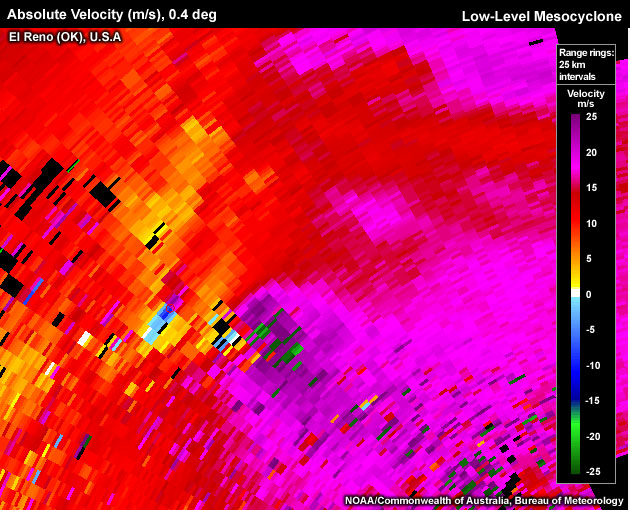
A tight anti-clockwise low-level mesocyclone in a supercell north of Oklahoma City on 3 May 1999. Note that the circulation centre is placed inside the extreme southwestern appendage to the main reflectivity core at low levels.
Low-Level Mesocyclone Look-a-Likes
- Poor velocity data - Most Australian Doppler radars use two pulse repetition frequencies (dual PRT) in order to increase their Nyquist velocity. Velocity data can therefore be affected by the performance of the unfolding algorithm, occasionally producing extreme values that are false. This example shows light blue pixels moving straight into red values, which implies too large an acceleration over a very short distance for a realistic situation. Moreover, the reflectivity data also suggests a rather non-severe looking cell.
Use the radio buttons or click the image to switch between reflectivity and velocity imagery:
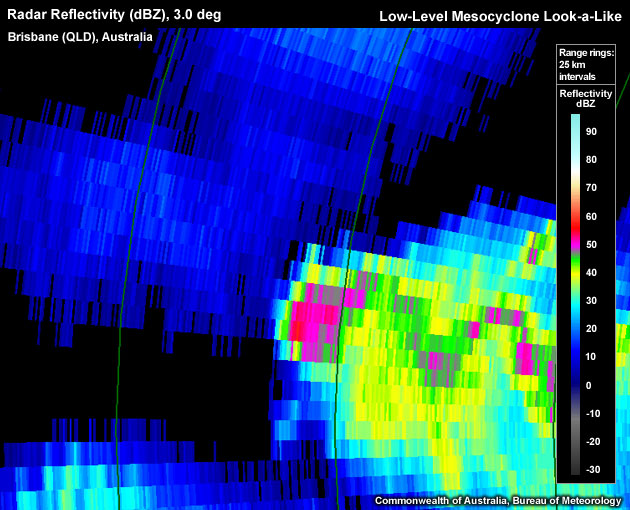
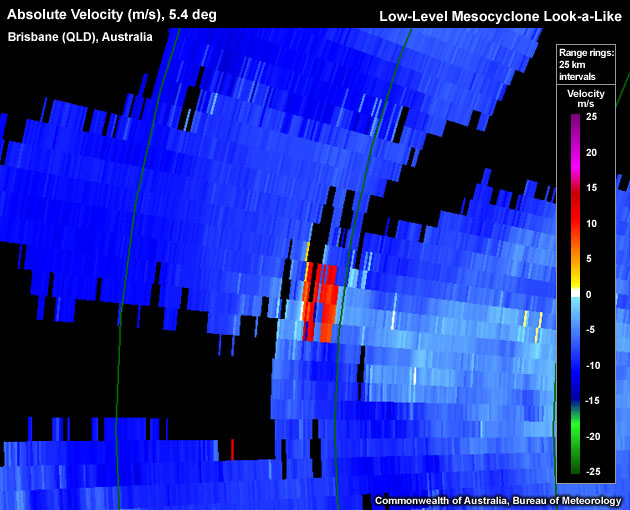
Corrupted velocity pixels that do not indicate rotation: step forward/backwards as well as up/down to confirm that this feature has no temporal or spatial continuity.
- Only shear - The rotational velocity is weaker than a minimal mesocyclone according to the mesocyclone nomogram (~15 ms-1).
Use the radio buttons or click the image to switch between reflectivity and velocity imagery:
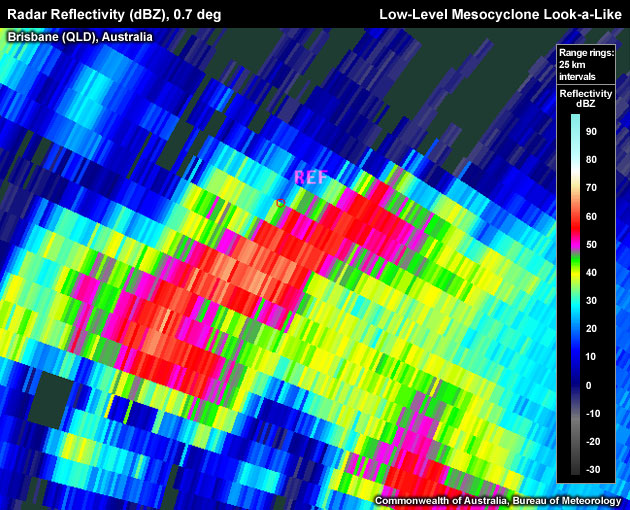
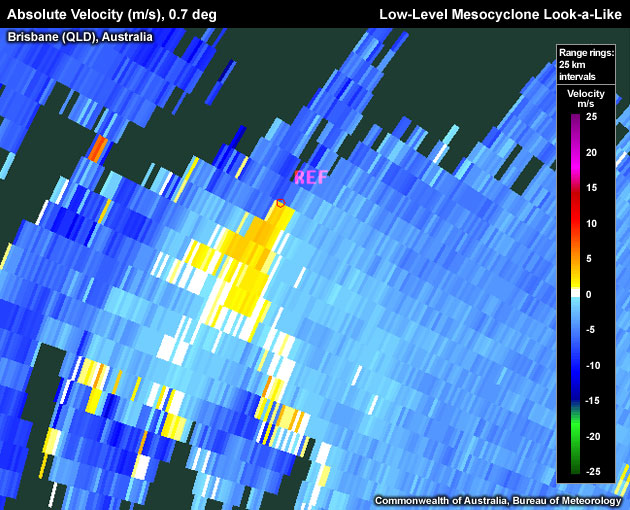
An intensifying storm shows a cyclonic circulation of insufficient rotational velocity for classification as a mesocyclone with outbound velocities of ~6 m/s, inbound velocites around ~13 m/s.
- Divergence/convergence - Can sometimes be confused with rotation. Note the white isodop in between the divergence or convergence signature.
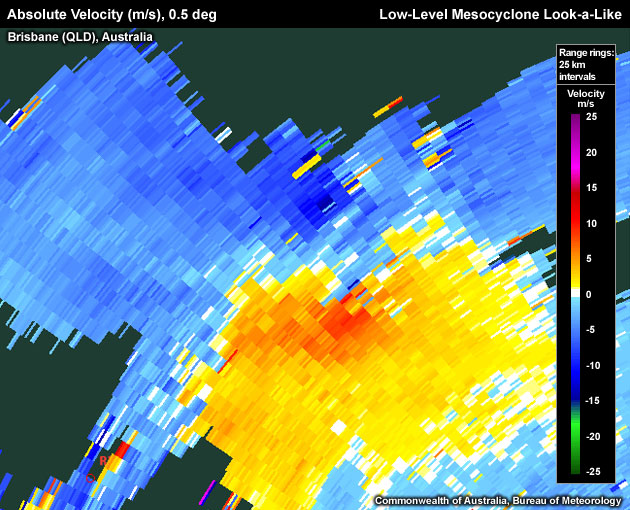
This image shows a hydrid signature between convergence and clockwise rotation with the convergent aspects being dominant.
- Not located in vicinity of updraft - To identify storm-scale rotation near the storm updraft, a true mesocyclone needs to be identified in the vicinity of such an updraft. Rotational signatures away from any updraft are therefore suspect.
Use the radio buttons or click the image to switch between reflectivity and velocity imagery:
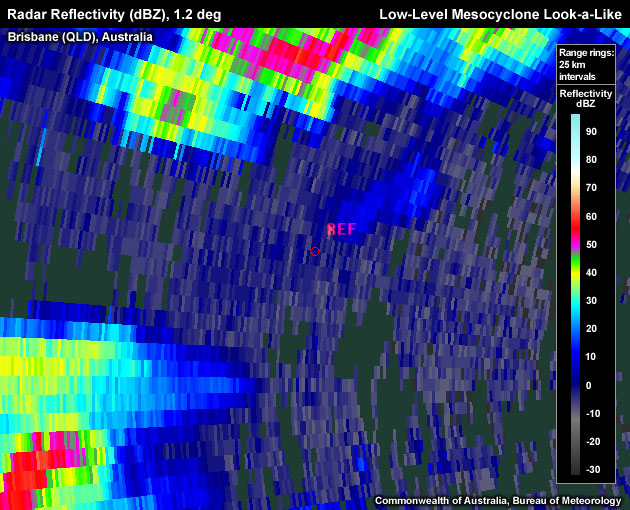

The velocity image shows what could be mistaken for a small but intense clockwise circulation. The corresponding reflectivity image confirms that the "circulation" is a radar artefact.
- No vertical extent ("single level vortex") - As detailed in the definition of a mesocyclone, a vertical depth of around 3 km or more is required for a mesocyclone.
- Too large a diameter - A broad area of rotation exceeding the 2-10km range might not represent a true mesocyclone but is more likely the result of larger-scale processes other than the tilting of horizontal vortex lines by an updraft.
Use the radio buttons or click the image to switch between reflectivity and velocity imagery:
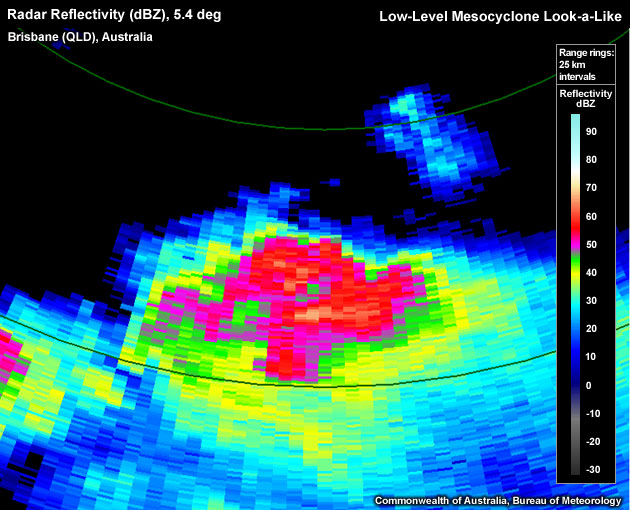
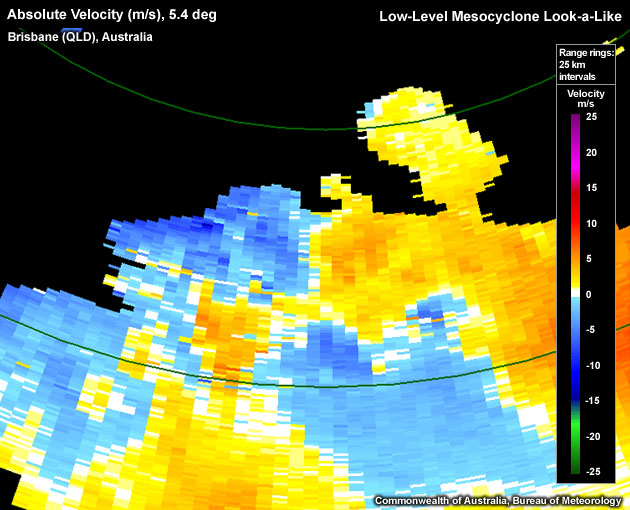
Broad area of rotation extending through the entire northern flank of the storm.
- Not persistent - A mesocyclone signature that is not evident for at least 10 minutes, is deemed not persistent enough for the signature to be classified as a mesocyclone.
Mesocyclones are the defining feature of supercell thunderstorms. To confirm that you are dealing with a supercell and anticipate its potential development and movement, see the Conceptual Model section.
